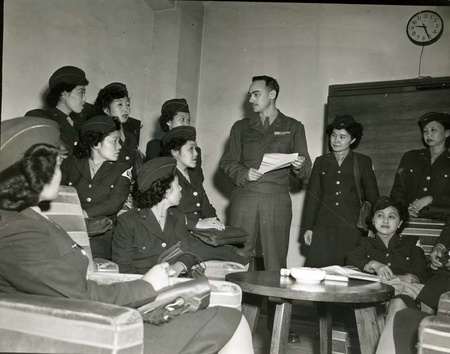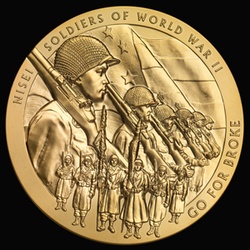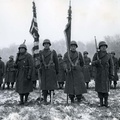Read part 1 >>
You Nisei volunteered from Hawaii and even the very internment camps in the United States.
As you volunteered, your fathers advised you that this is your country, your loyalty must be to the United States. They told you: fight if you must and die if you must, but remember, don’t bring shame to your family, to the community, or to your country.
Thirty-three thousand of you Nisei served this country, with incredible honor and distinction, unmatched in the military history annals of the United States. You Nisei knew that much was at stake and that you were to fight with all of your resources, to once and for all prove, to those who doubted, the loyalty of your families and your community.
The 100th Infantry Battalion and the 442nd Regimental Combat Team were segregated units. You fought in eight majors campaigns in Italy and France: Naples-Foggia, Anzio, Rome-Arno, Southern France, the Rhineland, North Apennines, Central Europe, and the Po Valley. You liberated numerous towns and villages throughout Europe, including the Italian port city of Leghorn, and the strategic town of Bruyères, France.
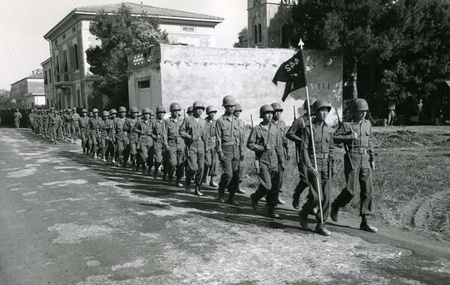
Company H, 442nd Regimental Combat Team, marches through a recently liberated town in Italy. The 442nd RCT captured and liberated numerous towns in Italy and in Southern France. Image credit: National Archives
You Nisei of the 100th Infantry Battalion and the 442nd Regimental Combat Team fought the toughest troops the Nazis could throw against you. They were battle-hardened troops from the Afrika Korps. SS troops, Panzer brigades, and soldiers from the Hermann Goering Division. You brave Nisei soldiers fought with the great divisions of the Fifth Army and the Seventh Army, including the 34th, 36th, and 92nd Divisions. You fought courageously alongside the 10th Mountain Division and the 45th and 91st Divisions.
You Nisei soldiers earned about 4,000 Purple Hearts. 719 Nisei men made the ultimate sacrifice and were killed in action. The 100th/442nd suffered the highest combat casualty rate of any unit in World War II. There was a replacement rate of 314%. Ironically, many of those who were killed or wounded had volunteered from American concentration camps. You Nisei were awarded 18,143 individual decorations for bravery, including: 21 Congressional Medals of Honor, 52 Distinguished Service Crosses; 1 Distinguished Service Medal; 588 Silver Stars; 22 Legion of Merit medals; 19 Soldier’s Medals; 5,200 Bronze Stars; and 14 Croix de Guerre, among many other decorations.
Incredibly, it became the most decorated unit for its size and length of service in the 238 year history of the United States Army. That record remains today. The 100/442 received an unprecedented eight Presidential Unit Citations.
The “Go For Broke” exploits of the Nisei 100th Infantry Battalion and 442nd Regimental Combat Team have been well publicized and recognized, and rightfully so, as the unsurpassed combat record of Japanese Americans who fought as an integral military unit in Italy and France. The Military Intelligence Service story, on the other hand, is one of numerous small units of Nisei soldiers who operated in teams of ten to twenty men assigned to every combat division, Army corps, and every campaign in the war against Japan. You Nisei were on detached service to the U.S. Navy, Marines, and Army Air Corps. You were assigned to the British, Australian, Canadian, New Zealand, Chinese, and Indian combat units.
It is also the story of much larger groups of Nisei who served at intelligence centers at army and area headquarters level. Three main intelligence centers were operated, in the Southwest Pacific Area under General Douglas MacArthur, the Central Pacific Ocean Area under Admiral Chester Nimitz, and the China-Burma-India Area (CBI) under General “Vinegar Joe” Stilwell.
Through it all, as indispensable translators of captured enemy documents, interrogators of enemy POWs, and persuaders of enemy surrender, you Nisei were superbly effective. You also worked laboriously over tons of enemy documents—maps, battle plans, diaries, letters, records, manuals—at area headquarters, producing voluminous intelligence of all sorts that affected Allied strategy and operations.
From the frozen tundra of Attu; to the coral atolls of the Pacific; the jungles of New Guinea, the Philippines, and Burma; the lava terrain of Iwo Jima; and the bloodied escarpments of Okinawa, you Nisei were everywhere, obtaining intelligence from enemy documents, POWs, and enemy communications, and calling upon the enemy to surrender. When needed, you operated behind enemy lines and parachuted on assignments without real parachute training. In Burma and elsewhere, you crept to within hearing distance of enemy troops to learn their movements, at times tapping and listening to the enemy’s telephone communications.
Major General Charles Willoughby, G-2, intelligence chief of MacArthur’s command, is credited with stating that you Nisei shortened the Pacific war by two years and saved a million American lives.
You might aptly use the words of Winston Churchill and state that “never had so many owed so much to so few.”
When the war ended in August of 1945, the work was not over for you Nisei, for now you were needed to bridge the language and cultural gap in the Allied Occupation of Japan. You did, performing again an indispensable role.
The U.S. occupation of Japan was one of the most benevolent and benign in world history. You Japanese Americans helped write new laws and create new institutions. You helped in the institution of the modern Japanese constitution. You helped institute progressive land reforms and civil rights for Japanese women. One of the reasons Japan is the modern nation that it is today is due to the role of you Japanese Americans in facilitating the transition from a military state to a democratic one. More than 5,000 Japanese Americans worked in Japan during the occupation, from 1945 to 1952.
For you Nisei of MIS, further, there was a certain compassionate dilemma to be resolved in your hearts and minds. Being Japanese by blood, whose parents had come from Japan, you would literally be fighting your kin, but your loyalty to country had to be upheld. You had been taught at home, “To thy parents be truly respectful and to thy country be utterly loyal.”
I had, myself, the honor to interview a number of you Nisei soldiers. I asked you, “Why did you volunteer for the Army?” Over and over again, you told me “It was so that my parents, my family, and my children could have a better life than I had.” You did it so that the racism that existed so prominently on Hawaii and the West Coast would be ended. You fought and sacrificed so that you would never have your loyalty questioned again.
You Niseis not only helped win the war overseas, but also helped win the war at home against prejudice, intolerance, and misunderstanding.
Indeed, your children and all of us are the beneficiaries of this incredible wartime military history.
Because of the wartime service of you Nisei soldiers, the 500 laws in California and Hawaii that stood against Asians were struck down. You Nisei saw your parents become citizens in 1954. You saw your parents vote for the first time and actually own their own land. You saw your children succeed in business and the professions. You saw your comrade soldiers become legislators and political leaders, advancing the cause of civil rights for other minorities and groups in America.
You might say you Nisei were the greatest generation within the greatest generation.
When you Nisei came home from the war, you didn’t tell your wives, your families, or your children of your wartime experiences. The reasons were many. Because of the painful loss of your friends, the trauma of war, and because of your value of enryo—humility.
In 1988, after a long period of soul-searching, America apologized to the Japanese American community for its failures during the war. The very act that promulgated this reconciliation with democracy was named House Resolution 442, after the 442nd Regimental Combat Team.
In 2000, 20 long-overdue Medals of Honor were awarded to Nisei in a ceremony at the White House.
One of the most remarkable legacies came after September 11, 2001. I remember clearly watching the news when President George Bush, standing alongside his Secretary of Transportation, Norman Mineta, assuaged the fears of Arab Americans by saying that we were not going to repeat the mistakes of the past and that Arab Americans had nothing to fear from their country.
In 2011, the Congress of the United States ordered its highest award, the Congressional Gold Medal, to you Nisei soldiers of World War II.
As former Army Chief of Staff Eric Shinseki said, “We stand on the shoulders of giants.”
A few years ago, I remember speaking to one of my K Company friends, Tosh Okamoto, and he said to me, “You know, the awarding of the Medals of Honor to our boys is sort of the icing on the cake. I’ve sort of been angry for a long time at my country and what happened to us during the internment. Getting redress and the apology, and having the country recognize my buddies, lifted a cloud from my head. I now really feel like I’m truly American, and it was all worth it.”
Let us all remember and learn from these great men, the 33,000 Nisei who fought their precious war 70 years ago and won their place in history.
* * * * *
Sgt Masa Sakamoto was from Northern California. He was killed in Sospel. I was told to go up and get his body and bring it down. We had a little service in the cave there and it was my duty as the Chaplain to search his pockets in order to get everything home that can be sent home. I found a letter…all of his brothers were in the army in Japan…some vandals in California had burned down his father’s home and barn in the name of patriotism. And yet this young man had volunteered for every patrol that he could go on. You know, you can’t give a medal high enough for a man like that. We don’t realize how much these boys in California had to go through…to find a letter like that and his going out on a patrol and being killed.
—Chaplain Hiro Higuchi, 2nd Battalion 442nd RCT
We were one well-trained unit. We knew exactly what these guys are gonna do. We knew they not gonna bug out on you, they gonna protect you. So that’s why we don’t have any outstanding heroes. We never leave a guy out there by himself. We’ll be all together. We fought as a unit. We would never leave a guy out there flat by himself and come back. We would fight together ‘til we get everybody out or take our objective. As simple as that. A lot of times if you have an organization where you leave a guy out there by himself, the rest of the guys pull away, you gonna have a problem. You have trouble later on. But we never did that. We always stayed together and fought as a team.
* * * * *
Go For Broke: Japanese American Soldiers Fighting on Two Fronts
November 12, 2013 – March 2, 2014
Japanese American National Museum
Go For Broke: Japanese American Soldiers Fighting on Two Fronts chronicles the history of Japanese American Nisei soldiers from the 100th Infantry Battalion, 442nd Regimental Combat Team, and Military Intelligence Service who served during World War II to prove their loyalty to the nation that had disowned them.
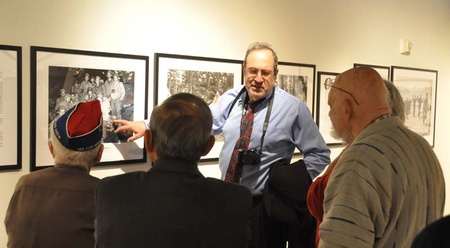
Eric Saul at the special Member Preview for "Go For Broke: Japanese American Soldiers Fighting on Two Fronts" on November 10, 2013 (Photo taken by Tsuneo Takasugi)
© 2013 Eric Saul


